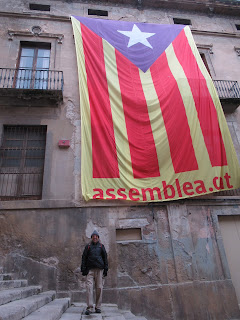I mentioned in one of the first posts I wrote about Barcelona that I would write a separate one about Catalunya because I referenced it in so many of the preceding posts about our time in the city. It's impossible for anyone to spend any time there and not hear or feel "You’re not in Spain, you’re in Catalunya." This was a popular nationalistic refrain we could tell from our first day in Barcelona. Catalunya, or Catalonia in English, was not the land of bullfighting and flamenco that automatically comes to mind when many tourists think of Spain. Madrid, Cordoba and Sevilla, where we are now, would be best for that.
I'm sure many of you may be wondering what Catalunya is as I was ignorant of more than the most basic details before traveling to the region. Catalunya is an autonomous community on the northeastern corner of Spain, designated as a nationality by its Statute of Autonomy. Catalunya consists of four provinces and its capital and largest city is Barcelona, the second-most populated city in Spain. It is bordered by southeast France and Andorra to the north, the Mediterranean Sea to the east.
Credit goes to travel writer Rick Steves for the following information. The region of Catalunya has its own language, history and culture. I read that its seven million people have a proud, independent spirit. Historically, Catalunya has often been at odds with the Spanish government and the Catalan language and culture were discouraged or even outlawed at various times in history, as Catalunya often chose the wrong side in wars and rebellions against the kings in Madrid. In the Spanish Civil War from 1936-1939, Catalunya was one of the last pockets of democratic resistance against the military coup of fascist dictator Francisco Franco, who punished the region with four decades of repression. During that era, the Catalan flag was banned so locals vented by flying their football team’s flag instead!
I'm sure many of you may be wondering what Catalunya is as I was ignorant of more than the most basic details before traveling to the region. Catalunya is an autonomous community on the northeastern corner of Spain, designated as a nationality by its Statute of Autonomy. Catalunya consists of four provinces and its capital and largest city is Barcelona, the second-most populated city in Spain. It is bordered by southeast France and Andorra to the north, the Mediterranean Sea to the east.
Credit goes to travel writer Rick Steves for the following information. The region of Catalunya has its own language, history and culture. I read that its seven million people have a proud, independent spirit. Historically, Catalunya has often been at odds with the Spanish government and the Catalan language and culture were discouraged or even outlawed at various times in history, as Catalunya often chose the wrong side in wars and rebellions against the kings in Madrid. In the Spanish Civil War from 1936-1939, Catalunya was one of the last pockets of democratic resistance against the military coup of fascist dictator Francisco Franco, who punished the region with four decades of repression. During that era, the Catalan flag was banned so locals vented by flying their football team’s flag instead!
An important symbol of Catalunya is the dragon which was slain by St. George – Jordi in Catalan – the region’s patron saint. During our almost week in the city, we saw dragons all over Barcelona as well as the Catalan flag. The flag, called the Senyera, has four horizontal red stripes on a yellow background. Nineteenth century Catalan Romantics embraced a vivid story about the origins of their flag. In the 9th century, Wilfred the Hairy, a count of Barcelona and one of the founding fathers of Catalunya, was wounded in battle. A grateful neighboring king rewarded Wilfred’s bravery with a copper shield and ran Wilfred’s bloody fingers across its surface, leaving four red stripes! Although almost certainly false, the legend hints at the nostalgic mood in 19th century Barcelona when the Catalan cultural revival prodded historians to dig deeply into their medieval past to revive obscure historical figures and lend legitimacy to the resurgent Catalan nation.
The Catalan language is irrevocably tied to the history and spirit of its people in Barcelona. After the end of the Franco era in the mid-1970s, the language made a huge comeback. Schools are now required by law to conduct all classes in Catalan; most schoolchildren learn Catalan first and Spanish second. While all Barcelonans still speak Spanish, nearly all understand Catalan, three quarters speak Catalan, and half can write it. All the signs we saw were in Catalan first, and then Spanish, I noted.
On October 27th, 2017, the Catalan Parliament declared independence from Spain following a disputed referendum. The Spanish Senate voted in favor of enforcing direct rule by removing the entire Catalan government. At the beginning of November, 2017, the Spanish Supreme Court imprisoned seven former ministers of the Catalan government on charges of rebellion and misuse of public funds, while several others, including the President Carles Puigdemont, fled to European countries. Stay tuned for more updates in future posts as we traveled through more of Catalunya.
Next post: Onto Girona & the Costa Brava, more of our almost six week journey through Spain.
Posted on December 3rd, 2018, from Sevilla, Spain.




'Wilfred the Hairy', what a funny name. Lil Red
ReplyDeleteFascinating history lesson .. thanks ! xo
ReplyDelete